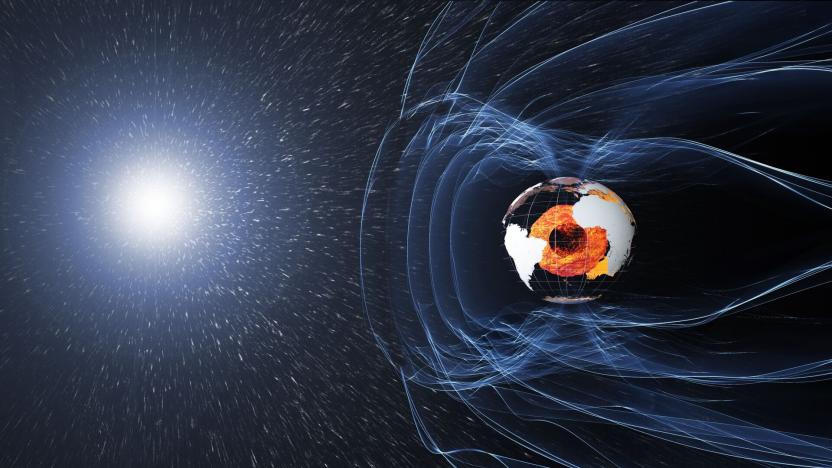solar storm
Latest

Listen to the eerie sounds of a solar storm hitting the Earth's magnetic field
Scientists converted data from the ESA's three Swarm satellites into ethereal audio.

Alt-week 7.8.2012: Solar flares, trapping dark matter, and life-sized Lego trees
Alt-week peels back the covers on some of the more curious sci-tech stories from the last seven days. This week we swing by some superhero news, look at how solar panels might shape up in the future, explore a Lego forest and see how to grab dark matter just using some household gold and strands of DNA. Not only that, we discover how the sun likes to celebrate the fourth of July with its own firework display. This is alt-week

Sun's coronal ejections caused by magnetic ropes, galactic weathermen to predict solar storms?
Space weather gets nasty when the sun starts shooting plasma into the cosmos, and these solar storms wreak havoc on both satellites and gadgets here on earth. Scientists want to predict the sun's eruptions so we can protect our gear (and know the best time to go tanning), and George Mason University researchers have made a discovery that may help us do so. By examining images from NASA's Solar Dynamic Observatory spacecraft, Professor Jie Zhang and grad student Xin Cheng determined that magnetic ropes are causing coronal ejections. The ropes are formed by several magnetic fields wrapped around each other, and scientists believe they can carry electrical currents strong enough to cause the plasma bursts. Prior to an eruption, Zhang observed a low-lying channel with unique electromagnetic properties (believed to be a magnetic rope) heat a portion of the sun's surface up to 10 million degrees. Once hot enough, the spot spewed forth copious amounts of the plasma and magnetic energy that gives GPS units and phones fits. Now that we know what gets Helios all riled up, we just need to find a way to calm him down. Close-ups of the sun in its tizzy are after the break.

Violent sun throws fit, massive blast of plasma to hit Earth tomorrow
Coronal mass ejections (CMEs) are no laughing matter, but for quite some time now we've been livin' easy as the sun kept it cool. That changes tomorrow, when a massive CME will hit our atmosphere, flung asunder by that great CFL in the sky, which apparently spent much of yesterday throwing a giant, solar tantrum. Scientists are saying that human life will probably not be exterminated thanks to our atmosphere, but GPS and cellular reception could be a little finicky tomorrow. We can't wait to see the anti-sun attack ads from Apple. Update: Twitter user d0mth0ma5 sent us this link to a NASA time-lapse of the ejection. Make your time. [Thanks, Eric]

Summer-loving NASA engineers launch SDO probe to worship the sun (video)
Say all you want about how bad your local forecast is, it's way more accurate than our local solar forecast. The last time we checked, solar storms are said to knock out GPS temporarily sometime in the next two years -- the kind of window that would make even the most suave meteorologist smirk. With the launch of the new Solar Dynamics Observatory we're hoping NASA can shrink that window down by, oh, at least a few months. The probe lifted off yesterday, perched atop an Atlas V rocket, and is now orbiting Earth. There it will study our sun with a series of optical and magnetic sensors, beaming data back at a rate of 150MBit/sec, making us ever so slightly jealous that this thing can get a better signal in space than we can down here on the surface. The launch fireworks are embedded below for those who weren't glued to NASA TV yesterday morning. [Thanks, Pavel]

Pentagon plan to save endangered satellites not without risks
As you may or may not know (we sure didn't), all those satellites orbiting our little ball of blue are highly susceptible to traumatic events such as intense solar storms or space-based nuclear blasts, and would likely be crippled by the resulting swarm of charged particles. The big brains at the Pentagon are aware of this danger, of course, and have come up with a solution called "radiation belt remediation" that would employ even more sats to broadcast low frequency radio waves into particle filled areas, creating so-called wave-particle interactions that would encourage the pesky molecules to fall harmlessly into the Earth's upper atmosphere. Sounds like a great plan, except a team of researchers at New Zealand's University of Otago believe that all those charged particles in the ionosphere would absorb the vital communications signals that are normally supposed to be reflected back down to terra firma. Long story short, by saving the satellites, communications on the ground would be severely hampered, affecting everyone from military personnel to amateur radio hobbyists -- and in a worst case scenario, GPS signal quality and accuracy could be severely degraded, much to the dismay of the burgeoning geocaching community. Still, if this is the only option we've got in the face of a nuclear attack, losing ground -based communications for a week or so is a small price to pay in order to save hundreds of satellites; we can deal with our in-car sat nav systems acting screwy for a little while, but we must protect our ability to receive XM/Sirius and DISH/DirecTV broadcasts at all costs.



